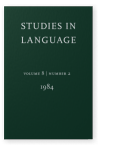Scott DeLancey
List of John Benjamins publications for which Scott DeLancey plays a role.
Journal
2023 Copula to negator: Grammaticalization of the copula #ni in Tibeto-Burman languages Studies in Language 47:3, pp. 505–525 | Article
Van der Auwera & Vossen (2017) identify an intriguing shift from a copula to a negative marker in the Tibeto-Burman Kiranti group, and discuss it as a possible example of Jespersen’s Cycle. This paper traces a fuller history of the copula #ni, and presents an account of its association with… read more
2019 Non-singular pronouns in Tibeto-Burman (Trans-Himalayan) Linguistics of the Tibeto-Burman Area 42:1, pp. 110–136 | Article
This paper surveys the forms of dual and plural pronouns across the Tibeto-Burman languages, and offers a reconstruction of the non-singular pronouns, and a general account of how various branches and languages have diverged from this original system. We can certainly reconstruct two, perhaps… read more
2018 Chapter 10. Deictic and sociopragmatic effects in Tibeto-Burman SAP indexation Typological Hierarchies in Synchrony and Diachrony, Cristofaro, Sonia and Fernando Zúñiga (eds.), pp. 343–376 | Chapter
The study of hierarchical argument indexation systems shows that while the ranking of both 1st and 2nd person over other arguments is robust and reliable, it is impossible to find any compelling crosslinguistic evidence for one or the other ranking of the two Speech Act Participants, and rare to… read more
2014 Second person verb forms in Tibeto-Burman Linguistics of the Tibeto-Burman Area 37:1, pp. 3–33 | Article
Since the beginning of research on the PTB verb agreement, 2nd person marking has posed a persistent problem. Every scholar who has dealt with the problem reconstructs a set of person/number suffixes including 2sg #-n(a). But there is also strong evidence for a #t‑ prefix which also indexes 2nd… read more
2013 The origins of Sinitic Increased Empiricism: Recent advances in Chinese Linguistics, Jing-Schmidt, Zhuo (ed.), pp. 73–100 | Article
A persistent problem in Sino-Tibetan linguistics is that Chinese is characterized by a mix of lexical, phonological, and syntactic features, some of which link it to the Tibeto-Burman languages, others to the Tai-Kadai, Hmong-Mien, and Mon-Khmer families of Southeast Asia. It has always been… read more
2011 Finite structures from clausal nominalization in Tibeto-Burman Nominalization in Asian Languages: Diachronic and typological perspectives, Yap, Foong Ha, Karen Grunow-Hårsta and Janick Wrona (eds.), pp. 343–360 | Article
Nominalization has long been recognized as one of the driving processes of Tibeto-Burman syntax and syntactic change. A pervasive and recurrent process in the family is the replacement of old finite clause structures with new constructions based on nominalizations. TB languages repeatedly innovate… read more
2007 Zygmunt Frajzyngier and Erin Shay. Explaining language structure through systems interaction Functions of Language 14:2, pp. 277–283 | Miscellaneous
2005 Adpositions as a non-universal category Linguistic Diversity and Language Theories, Frajzyngier, Zygmunt, Adam Hodges and David S. Rood (eds.), pp. 185–202 | Article
2003 Location and direction in Klamath Motion, Direction and Location in Languages: In honor of Zygmunt Frajzyngier, Shay, Erin and Uwe Seibert (eds.), pp. 59–90 | Article
1997 Grammaticalization and the Gradience of Categories: Relator Nouns and Postpositions in Tibetan and Burmese Essays on Language Function and Language Type: Dedicated to T. Givón, Bybee, Joan L., John Haiman and Sandra A. Thompson (eds.), pp. 51 ff. | Article
1991 The Origins of Verb Serialization in Modern Tibetan Studies in Language 15:1, pp. 1–23 | Article
1987 Transitivity in grammar and cognition Coherence and Grounding in Discourse: Outcome of a Symposium, Eugene, Oregon, June 1984, Tomlin, Russell S., pp. 53–68 | Article
1986 Toward a History of Tai Classifier Systems Noun Classes and Categorization: Proceedings of a symposium on categorization and noun classification, Eugene, Oregon, October 1983, Craig, Colette G. (ed.), pp. 437 ff. | Article
1985 The analysis-synthesis-lexis cycle in Tibeto-Bruman: a case study in motivated change Iconicity in Syntax: Proceedings of a symposium on iconicity in syntax, Stanford, June 24–26, 1983, Haiman, John (ed.), pp. 367 ff. | Article
1984 Notes on Agentivity and Causation Studies in Language 8:2, pp. 181–213 | Article
1982 Aspect, Transitivity, and Viewpoint Tense-Aspect: Between semantics & pragmatics, Hopper, Paul J. (ed.), pp. 167 ff. | Article
















